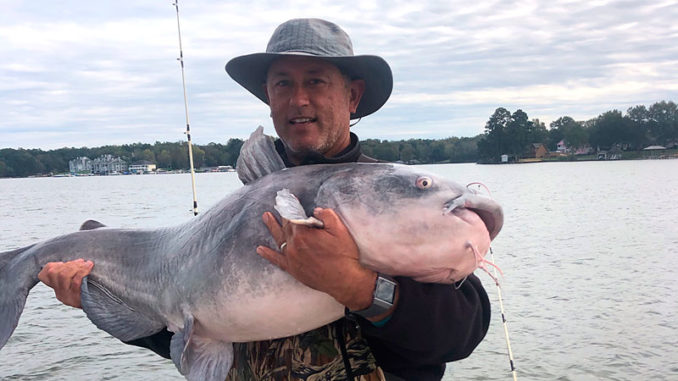
Catfish are feeding up on Lake Wylie
What makes November a prime time for catfishing at Lake Wylie on the North Carolina-South Carolina border near Charlotte?
Rodger Taylor of Rock Hill, S.C., who operates Catfish On! Guide Service said there are three very good reasons:
“Less boats on the water; the weather is usually very tolerable; and fish are feeding up.”
Catfish are scattered from one end of 12,455-acre Wylie to the other in November. But Taylor (803-517-7828) said it may pay off to fish the deeper, lower end as the odds will be better with more hungry fish in a known location.
“Blue cats will usually move to the lower basin of Lake Wylie in numbers as temperatures start to drop, days shorten and bait moves toward deeper water. The fish will follow,” said Taylor. He usually starts out drift-fishing so he can cover large areas of deeper ledges on both the main-river channel and the creek mouths that join it.
“I like to probe some of the deepest depths, from 25 to 45 feet, around sharp river and creek ledges,” he said. “Using a trolling motor is a plus when the wind isn’t blowing hard. That’s because it allows me to place baits more precisely on the ledge. If winds are moderate, I like to use a large drift sock and allow the wind to propel my boat. Keeping drift speeds around one-half mile per hour is optimal.”
Drift or anchor?
Drifting is his primary technique in November. But Taylor said he will fish from anchor if conditions dictate.
“Anchoring is a good bet when we have received heavy rainfall and the waters are on the rise,” he said. “When freshwater is moving into the lake, it always pays to check out the bottom bite where water flows into major creeks on the lower end of Lake Wylie.”
In November, Taylor targets the backs of creeks in 5 to 15 feet of water to anchor.
“You’re looking at fan-casting baits from 5 to 20 feet to get a good coverage from shallow to deep water while anchored midway back on secondary points that run out into the creek in large creeks like Allison and Torrence on the lower end of the lake,” he said.
The very backs of creeks are a good bet also when afternoon temperatures warm the shallow waters and baby shad school up in those areas. Late afternoon often is the best time for this tactic, he said. “Often the bite can be hot right at dark as days get shorter.”
Taylor prefers gizzard shad for bait when available. But white perch are a good substitute, he said.
Bait choices
“Gizzard shad start to get a little difficult to locate as the water cools down. Best times to find them are in the afternoons when the wind is calm and waters have warmed back in the creeks,” Taylor said. “White perch are readily available and easy to catch on rod and reel, bottom-bumping with a Sabiki rig baited with worms or cut shad.”
Taylor said on a good day in November, anglers can expect to hook up with a dozen or so blue catfish ranging from about 6 to 18 pounds. But odds are also good for a bonus catch.
“Some of the biggest catfish of the year are caught this time of year,” said Taylor.




Be the first to comment